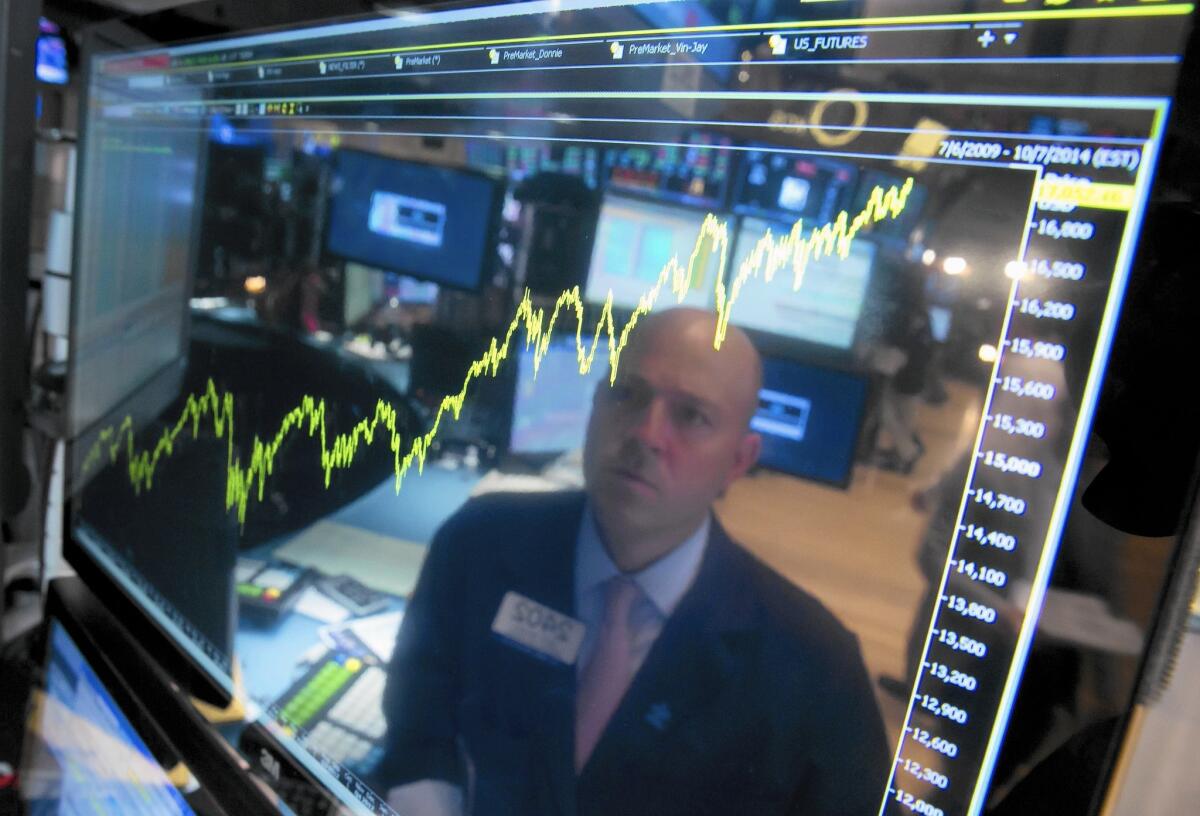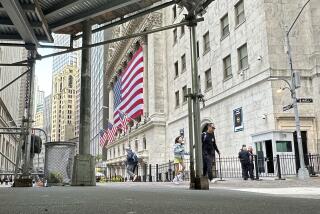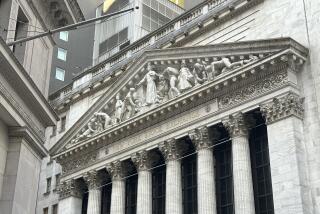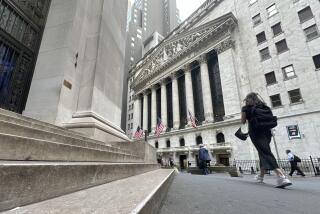U.S. bull market rolled on in 2014, but investors got pickier

Investment success in 2014 was mostly about keeping it simple. That may not be a bad way to go in 2015, either.
Well-known U.S. blue chip shares handily beat obscure smaller stocks and most foreign markets over the last 12 months. High-quality bonds trounced lower-quality issues. Gold lost 1.6%, falling with most other commodities.
And the typical “target-date” retirement investment fund earned between 5% and 6% — boring, perhaps, but far better than the return on the average high-cost hedge fund for the well-heeled.
The Dow Jones industrial average ended 2014 with a daily loss of 160 points, or 0.9%, to 17,823.07 Wednesday. But for the year, the 30-stock Dow rose 7.5%, its sixth consecutive annual gain as stocks have continued to recover from the financial-system crash of 2008.
Investors’ moves in 2014 were driven in large part by a bifurcated global economy: surprising strength in the U.S. while much of the rest of the world struggled. Diving oil prices in recent months helped re-energize Wall Street optimists.
Here’s a breakdown of how key markets fared for the year and a look ahead:
U.S. stocks
The bulls were in control for a sixth year, but they got a lot pickier after the roaring market of 2013.
Many investors seemed to focus on playing it safer by favoring conservative stocks over more speculative issues. That strategy was fueled in the first half of the year by a winter-weather-induced slowdown in U.S. economic growth, then in the second half by waning growth abroad and by expectations of a Federal Reserve interest-rate hike in 2015.
“The year was about staying long [invested] but reducing riskier plays,” said Justin Walters, a principal at investment research firm Bespoke Investment Group in Harrison, N.Y.
The blue-chip-dominated Standard & Poor’s 500 index, a benchmark for many Americans’ retirement investment accounts, rose 11.4% for the year after slipping 1% to 2,058.90 on the final trading day. By contrast, the S&P index had rocketed 29.6% in 2013, its best performance since 1997.
The S&P, the Dow and most other major indexes had reached record highs just last week before pulling back. The technology-heavy Nasdaq composite index, which eased 0.9% to 4,736.05 Wednesday, was up 13.4% for the year and last week hit its highest level since its dot-com era peak of 5,048 in 2000.
This time around, Nasdaq has been powered much more by highly profitable tech giants than by the start-ups that led the market frenzy in 2000. The biggest gainer among the Dow 30 stocks in 2014 was chip maker Intel Corp., up nearly 40%. And shares of Apple Inc., the nation’s largest company by stock market value, surged 38% for the year.
By contrast, small-company stocks — the market stars for much of the last decade — dimmed. The Russell 2000 index of smaller stocks added just 3.6% for the year.
Sam Stovall, U.S. investment strategist at S&P Capital IQ in New York, noted that investors typically move away from riskier small stocks and toward blue chips when they’re concerned that the market could be headed for a fall.
That mentality also boosted shares of electric and gas utilities, he said: Of 10 major industry stock sectors in the S&P 500, normally staid utilities were the top performers by a long shot, gaining 24% for the year.
The hefty advance in utilities confounded stock mutual fund managers, who usually stay away from dull market sectors in search of more exciting ideas. That was another reason why most actively managed mutual funds in 2014 trailed well behind low-cost “passive” funds that simply own all of the stocks in a particular index, such as the S&P 500.
Another popular type of index fund, target-date retirement funds that own a mix of stocks and bonds, mostly posted gains of 5% to 6% for the year, according to data firm Morningstar Inc. Though modest, those returns were trouncing the 2% average return of sophisticated hedge funds as of early December, according to data compiled by Bloomberg News.
Many analysts expect the first half of 2015 to be a tug-of-war between optimism over the economy — especially given cheaper oil — and nervousness over expectations that the Federal Reserve will begin lifting its benchmark interest rate, now near zero, around mid-year.
Continued corporate earnings growth underpinned stocks last year, and should do the same this year, bulls said.
With the S&P 500 priced at about 17 times expected 2015 earnings per share, stocks aren’t historically cheap, but neither are they excessively overvalued, Stovall said.
If modest Fed interest-rate hikes don’t wreck the economy, Walters said, “it’s tough to take up a bearish strategy given everything else that’s going on.”
Foreign stocks
Anemic economic growth in much of the world outside the U.S. set the scene for a weak year for many foreign stock markets. And for U.S. investors abroad, the situation was worsened by the dollar’s sharp rise against the euro, the Japanese yen, the Canadian dollar and other rivals.
In local currencies, stocks were up 7.4% for the year in Canada, 7.1% in Japan, 2.6% in Germany, 0.7% in Australia and 0.1% in Mexico. They were down 0.5% in France, 2.7% in Britain, 2.9% in Brazil and 4.8% in South Korea.
But after accounting for the dollar’s appreciation, U.S. investors’ returns were even lower in many foreign markets last year.
The average foreign-stock mutual fund lost 3% to 6% for the year, according to Morningstar.
For U.S. investors, poor-performing foreign stocks have become an old and frustrating story. Over the last five years, the average European stock fund, for example, has gained 6.5% a year. That’s less than half the return on the average U.S. stock fund.
U.S. stock valuations relative to foreign stocks are at their highest levels of the last 30 years, said Mebane Faber, chief investment officer at Cambria Investment Management in El Segundo.
That’s why many strategists, such as David Kotok, head of money manager Cumberland Advisors in Vineland, N.J., expect a rebound in foreign equities this year, particularly in Europe.
Kotok said he believes the European Central Bank soon will launch a “massive” program to push cash into the euro-zone economy by buying up government bonds, similar to what the Federal Reserve did in the U.S. for most of the last five years.
The result: “Conditions will improve over the present recession levels, and the stock markets in Europe are likely to reflect that improvement,” Kotok said.
The risk, however, is that the ECB holds back or is too timid with an economic-stimulus program.
That could stoke more fear that Europe will follow Japan, which despite aggressive stimulus in recent years saw its economy shrink again in the third quarter.
Bonds
One of the biggest market surprises last year was that long-term interest rates continued to fall, even from very low levels at the end of 2013. The main driver of lower rates was punk economic growth in much of the world, which pushed many investors into the relative safety of bonds.
The benchmark 10-year U.S. Treasury note yield ended the year at 2.17%, down from 3.04% a year ago. In Europe, some government bond yields hit record lows. Germany’s 10-year government yield ended at 0.54%, down from 1.95% a year ago.
And as with stocks, bond investors tended to favor high-quality issues. That meant money flowed into government bonds and municipal issues, and out of below-investment-grade corporate issues, so-called junk securities.
Among bond mutual fund categories, the average fund in the popular intermediate-term government bond sector rose 4.6% for the year, counting interest earned and price appreciation, according to Morningstar. Tax-free municipal bonds fared even better, with the average long-term California muni fund up 11.9%.
The argument against bonds now is that, with yields so low, there’s nowhere to go but up if the global economy improves in 2015. But that’s still a big “if.”
With Europe facing the threat of deflation — a sustained decline in prices and wages — the onus is on the ECB to revive growth.
Many investors expect long-term rates to move up if the Fed begins raising short-term rates. But Jeffrey Gundlach, who heads bond-fund firm DoubleLine Capital in Los Angeles, told a group of investors in December that if European bond yields stay at record lows there is “no chance” of U.S. bond yields rising in 2015.
More to Read
Inside the business of entertainment
The Wide Shot brings you news, analysis and insights on everything from streaming wars to production — and what it all means for the future.
You may occasionally receive promotional content from the Los Angeles Times.










